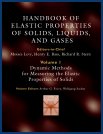 |
 |


Handbook of Elastic Properties of Solids, Liquids, and Gases
Overview of the Handbook
Sound waves propagate through galactic space, two-dimensional
solids, biological systems, and through everything that surrounds
us: the earth, the sea, and the air. The elastic properties of materials
determine their sound velocity and provide us with invaluable information
about their response to stresses.
The four volume Handbook of Elastic Properties of Materials,
edited by Henry Bass, Moises Levy, and Richard Stern provides these
properties in a concise and approachable manner for almost everything
whose elastic properties have ever been measured or deduced. Leading
experts explain the significance of the elastic properties as they
relate to intrinsic microscopic behavior, manufacturing, construction,
or diagnosis making the Handbook an invaluable tool for scientists
and engineers. They discuss the propagation of sound in newly discovered
or created materials, and in common materials that are being investigated
with state-of-the-art dynamic measurement techniques.
The Handbook is the first book to provide in one source
information on solids, liquids, and gases, along with properties
of esoteric substances, such as normal and dense stars, superfluid
helium three, fullerenes, two dimensional solids, extraterrestial
substances, gems and planetary atmospheres. The first volume of
the Handbook is dedicated to the measurement techniques involved
with elastic properties. Volume Two, Elastic Properties of Solids,
covers a wide range of topics, including theory, elements and compounds,
novel and technological materials, and alloys. The third volume
is concerned with the elastic properties of solids that are derived
from biological and organic materials or are involved with earth
and marine sciences. Finally, the fourth volume deals with the elastic
properties of liquids and gases.
.
Handbook Home
Physical Sciences Home
Secure Online Orders
|



